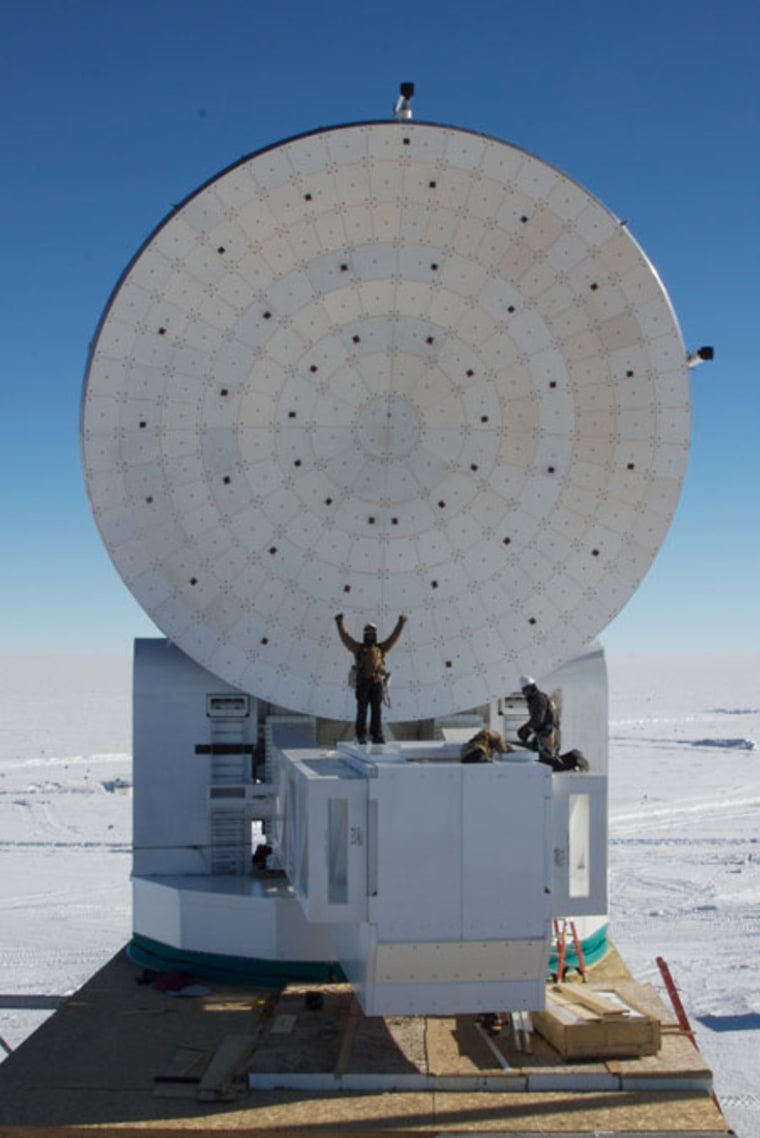A telescope at the South Pole is being fine tuned to search for gravity waves, hypothetical distortions of space-time that, if confirmed to exist, could further validate Einstein and reveal convincing evidence for a big cosmology theory.
Cosmic inflation theory proposes that the early universe passed through a phase of exponential expansion, ballooning almost instantaneously from less than the size of an atom to about golf-ball size.
The theory is widely accepted. It's tied up with the big bang theory of how the universe started and predicts the existence of gravity waves, as well as fluctuations in the density and temperature of radiation left over from the big bang (called the cosmic microwave background, or CMB) and the mass density of the universe. However, unlike CMB and mass density observations, gravity waves have remained elusive.
New approach
University of Chicago astrophysicist John Carlstrom and his colleagues now plan to place a new instrument on the South Pole Telescope to search for signals of gravitational waves, taking delicate measurements of the CMB. The telescope already has been probing the CMB for dark energy, a repulsive force that pushes the universe apart and overwhelms gravity.
"We'll know in 10 years whether or not we can detect gravitational waves from inflation," Carlstrom said last week to a group of reporters at the annual meeting of the American Association for the Advancement of Science, in Chicago.
Inflation theory predicts that gravitational waves were imprinted on the CMB when space-time inflated. The waves travel at the speed of light, but they are so weak that scientists expect to detect only those created during colossal cosmic events, such as black hole mergers. Also they have a wavelength that is hard to fathom — almost the size of the visible universe. The Laser Interferometer Gravitational Wave Observatory (LIGO) in Livingston, La., is one detector already designed to spot the elusive waves.
Einstein's theory of general relativity also predicted that shifts in large amounts of mass or energy would disrupt the fabric of space-time and generate regional ripples of gravitational radiation. They would be imperceptible to us. However, the gravitational radiation could also be detected indirectly through its polarizing effect on the CMB.
Seeking polarization
Here is how it could work. Inflation theory predicts that quantum fluctuations in the universe have been stretched out to cosmic sizes and became the seeds for the large-scale structure of the universe.
One class of these fluctuations has already been observed — fluctuations in the density of subatomic particles throughout the universe, Carlstrom said. A second class of these fluctuations is gravity waves, which he and other physicists think could be detected by telescopes tuned to the proper frequency of electromagnetic radiation.
Carlstrom's team is building a special instrument, a polarimeter, to be attached to the South Polar Telescope, to search for gravity waves. The telescope operates at submillimeter wavelengths, between microwaves and infrared on the electromagnetic spectrum. The idea is to search for the signature of gravitational waves in the CMB, which could be imprinted with polarization as a result of the waves.
A European space mission called Planck, more sensitive than the mission that found the cosmic microwave background, is set to launch in April, also in an effort to look for the polarization feature.
The 'smoking gun of inflation'
It's possible that inflation theory is entirely wrong. So discovery of gravity waves would be a big deal and go a long way toward validating the theory, as well as the big bang and some other big cosmological claims.
At the AAAS meeting, Arizona State University's Lawrence Krauss said he was pessimistic about the potential for cosmology to make new discoveries, based on the expansion of the universe. However, the possible detection of gravity waves excites him.
"The amazing thing about inflation is that it is completely consistent with what we see," he told reporters. "I think many people think that what's been called a smoking gun of inflation is gravitational waves. It's a prediction of inflation that is ubiquitous. It's a generic thing. If these waves are discovered ... if we detect gravitational waves from inflation, there is a real possibility of pinning things down enough so that one could perhaps convince every physicist that inflation happened."
Strangely, a negative finding disconfirms nothing, Krauss said. "The absence of gravitational waves is completely consistent with inflation," he said.
Still it's hard to see how inflation theory could be wrong, said Scott Dodelson, a University of Chicago physicist who also spoke with reporters at AAAS, because it explains so many observations. "Inflation allows an explanation of many of those features which for right now, there is no other explanation," he said.
"We have these key components to our picture of the universe, but we really don't know what physics produces any of them," he said, referring to inflation, dark energy and dark matter — the proposed stuff that makes up the universe's missing mass. "The goal of the next decade is to identify the physics."
